GAZA 2005
by Bernice Lipkin
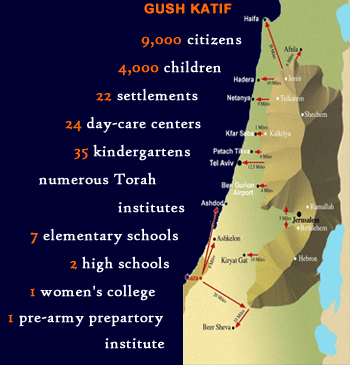
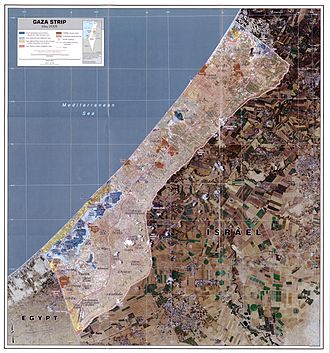
|
After the Six Day War, Jews came back to Gaza and in Gush Katif, a small area of desolate land that had been agriculturally dead for centuries, they created their own Garden of Eden.
To quote from Wikipedia (http://en.wikipedia.org/wiki/Gush_Katif):
"In the Katif Bloc's unique greenhouses, a uniquely developed advanced technology was used to grow bug-free leafy vegetables and herbs answering to the strictest health, aesthetic and religious requirements. Most of the organic agricultural products were exported to Europe. In addition, the community of Atzmona had Israel's largest plant nursery, and with 450 cows[Wiki's figure of 800 is incorrect-BSL], the Katif dairy was the second largest in the country. Telesales and Printing were other notable industries.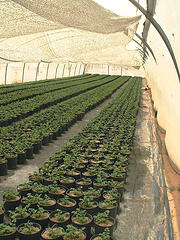
Anita Tucker's new celery seedlings, Netzer Hazani "The total sum of exports from the greenhouses of Gush Katif, which were owned by 200 farmers, came to $200,000,000 per year and made up 15% of the agricultural exports of the State of Israel. The combined assets in Gush Katif were estimated at $23 billion. Of Israel's total exports abroad, the Gazan Jewish community produced 95% of Israel's bug-free lettuce and greens, 70% of its organic vegetables, 60% of all the cherry tomatoes grown and 60% of geraniums sent to Europe."
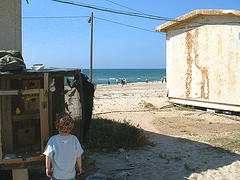
They lived in a dangerous area. Some of their Arab neighbors worked in their greenhouses while others shot at cars driving by, blew up school buses and invaded Jewish houses at night to knife babies asleep in their cribs. Aside from the occasional barbarity of their neighbors, they lived normal lives, secure in their community, pleased that they were contributing mightily to Israel's economy and security. In retrospect, what seemed a horrific number of murders and missiles seems tame, now that the Arabs have more land and better weaponry with which to display their talents.
THEN, EARLY IN THE 21ST CENTURY, Prime Minister Sharon presented the most cockamamy peace plan yet devised — and he's had much competition before and since. He declared that the Jews would vacate Gaza unilaterally. Naturally, peace would flow into this vacuum.
More realistic brains punched holes in his blather. In an far-sighted essay that could have been written today, David Shalom, a leader of Betar in the UK and a research chemist working in the field of nanotechnology, (http://www.think-israel.org/may05bloged.html#may05.291) said:
The plan to expel 9000 Jews from Gush Katif and the Northern Shomron (Samaria) is a precedent for disaster that will endanger the entire state of Israel and the Jewish people. The fight to save Gush Katif is a fight to save the entire state and is a struggle for the very survival of Zionism. There have been several arguments made by the proponents of this suicidal plan which are amateurish at best and deceitful at worst. The New Left, headed by the Likud turncoats including Ariel Sharon himself, as well as the Old Left, headed by the ancient Peres and united with the Arab MKs, have railroaded this plan through the Knesset without a mandate of the people and hope to soon force this calamity upon the nation. Therefore it is necessary to highlight the gaping holes in their logic and to expose the distortions that they have been spinning with the full complicity of the Leftist-traitors that control most of the Israeli media.
The argument that we hear over and over again is that the expulsion is necessary since "disengagement", as the plan is euphemistically called, will combat the demographic threat from the hostile Arabs living in the Gaza coastal region of Southern Israel. We are told that it is impossible for 8000 Jews to live amongst 1.5 million Arabs! Firstly, this is a half truth at best since the Jews of Gush Katif are not living inside Gaza city but outside of it and any child who looked at a map of the region could know this. Secondly the number of Arabs in Gaza is far less than that. Indeed a recent comprehensive study presented to the American Enterprise Institute shows that the numbers of Moslems living in Yesha[Judea, Samaria and Gaza] have been ballooned by the PLO and in Gaza, for example, their numbers are actually just under 1 million people. Perhaps more importantly, though is the deeper implication of this logic which ultimately precludes the existence of Israel within any borders. Israel is a state of less than 6 million Jews surrounded by 250 odd million Moslem Arabs — so should we dismantle the state? Isn't the demographic problem impossible to solve? The past century or so of Zionism show that the renewal of the Jewish people within the land of Israel is a glorious feat that will not be defeated by Arab aggressors. We see that such doom merchants, with their history of the "Ghetto" mentality of fear and subservience to the anti-Semites have been proved wrong.
History teaches us that the Arabs, who are the authors of the conflict, will have to pay with territorial concessions. A reasonable position for a true Israeli leadership to hold should be that there can be no peace with the Arabs until they take responsibility for their brothers and resettle them within their huge lands. It is not the Israelis, as refugees from the Arab world (as well as Europe) and after 60 years of Arab-initiated conflicts, who should be the ones to surrender territory. Israel is smaller than New Jersey, whereas the Arab world is 500 times its size. The Arab states who have fought Israel in the name of their brothers must now accept the burden of their resettlement as a small compensation for their aggression against Israel and the destruction of Middle Eastern Jewry within their lands. If it is possible to relocate thousands of Jews then surely it is only just and reasonable to advocate the relocation of the Arabs. This is both the only humane option and the true peaceful solution to the problem of thousands of impoverished, fanatical Moslems living in Gaza. Let the Arabs use a small fraction of their oil wealth to build their new homes in Syria and Jordan. Let the Quartet set up programmes to help them adjust to their relocation. This will not be especially hard since they share the same language, nay dialect, as well as history, religion and culture as their Syrian brothers.
The other ludicrous argument that is made by the Sharon-Peres regime is that the expulsion plan will allow Israel to separate from Gaza. But this is simply untrue. Israel will still be fully engaged in Gaza, Israel will still provide the Arabs with their electricity, water and of course employment. Thousands of enemy civilians will be allowed to cross the border daily to work in Israel. So whom are we disengaging from exactly? What benefits do we get from this? We are also told that this plan will save Israel money- but how exactly? The government's own conservative estimates suggests that the plan will cost Israel nearly 8 billion Shekels - that is equivalent to 1 billion BP! Is this is the same government that says it does not have enough money to pay for hospital beds for cancer patients? But then again this is the same government that found the funds to appoint 6 new deputy ministers! These ministers just coincidentally happened to be the Likud Knesset members who voted against the Referendum law in direct contravention of their party's decision!
Sharon has claimed that his plan will reap Israel international rewards particularly in the form of American approval for the annexation of major Jewish population centres around Yerushalayim. Aside from the fact that Israel does not need American recognition and the very idea that we have to accede to our "masters" in Washington's every wish utterly reeks, the statement has been proved to be utterly false. In fact America's ambassador to Israel, Ghetto-Jew, Dan Kurzer let this slip at a recent briefing to foreign ministry juniors. Kurzer actually stated the obvious, namely that the US has not made any commitments to recognise any Israeli towns in Yesha.
The expulsion plan will embolden the Arabs who will rightly see the withdrawal as a victory and as a prize for their terror. The Oslo war, which they initiated 4 years ago was ignited by Ehud Barak's surrender and retreat from Lebanon. The surrender of Gaza will bring the terrorist menace closer to Israel's larger population centres. The 50 Kassam missiles that were fired on Gush Katif, on the day after Sharon concluded a hudna (cease-fire) with PA chieftain Abu-Mazen in Sinai, will be but a drop in the ocean when the Philadelphi route and Gush Katif are in the hands of the PLO and their Hamas allies. The Kassams missiles will then reach Ashkelon and Ashdod and Strellar missiles, recently smuggled from Egypt, may threaten Israel civilian aircraft.
The most disturbing aspect of the plan is the precedent it will set. If one town or village can be uprooted in Israel than so can all towns. As Professor and MK Aryeh Eldad rightly pointed out, the struggle for Gush Katif is the struggle for Yerushalayim and ultimately the whole country. The world's hostility to the settlement enterprise was based on the premise that such towns once established were impossible to remove, but with "disengagement" completed the push for the surrender of all of Erets Yisrael will only grow. Israel enemies will rejoice and continue their struggle with renewed vigour. Arik Sharon is indeed disengaged, from his party, from his people and most worryingly of all from reality.
But reason didn't have a chance.
WELL BEFORE THE JEWS WERE DISENGAGED from their homes and businesses, beachfront property such as the Maoz HaYam Hotel was confiscated by the government and shut down. The photo below shows the hotel in August, 2005 occupied by people who came from all over to make a stand as the Day of Disaster approached.
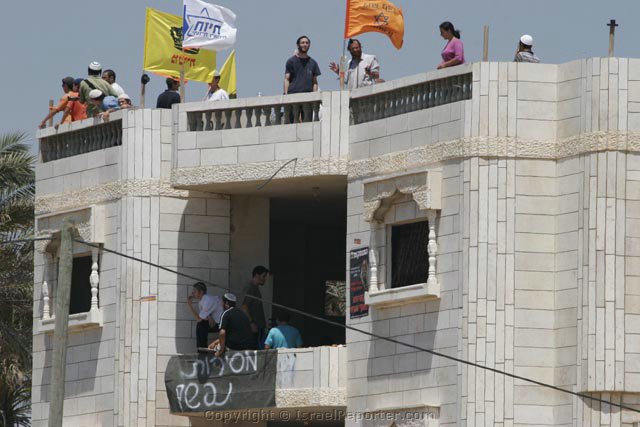
Orange was the color of cohesion. The good guys wore orange bracelets and orange tee-shirts. For the most part, American Jews looked the other way. And much of the media, foreign and domestic, praised Sharon's courage in wiping out the Gazan Jewish community to achieve peace.
In July, a demonstration was scheduled at Netivot, in southern Israel. Afterward, the protesters intended to continue on to Gush Katif to show support. At Kfar Maimon, near Netivot, the police and soldiers, some 20,000 strong, were out in force, to prevent the protesters from continuing on to Gush Katif, which was declared a closed military zone, open only to the residents. A vivid account of the gathering at Kfar Maimon written by a participant can be found here.
Protester numbers were reduced because the police had blocked cars wearing orange banners; regularly scheduled buses were canceled; privately owned buses throughout the country were prevented from traveling towards Gaza. Permits were denied. Even so, tens of thousands of people walked to show solidarity with Gush Katif, some wheeling small babies, all trudging in the blistering heat. The elements for violence were all in place at Kfar Maimon. The media came to see blood shed. Caroline Glick described the scene this way:
[The media] had to send in the pictures of what they saw. And what they saw was the truth they have been insistently denying for the past 30 years. Namely, that these Israelis have nothing in common with their demonized image. Here were tens of thousands of peaceful protesters singing and dancing and studying together. Here they were, handing fruit and drinks to the soldiers and policemen sent to stand against them and, rather than fighting with them, they prayed with them. For the first time, perhaps ever, both the general public in Israel and the world were able to receive undistorted images of these people on their television screens.
Many of the soldiers called up to expel the Gush Katif community were themselves living in the Territories. Glick noted that "thirty percent of the soldiers in the Golani Infantry Brigade live in Judea, Samaria and Gaza. These soldiers laid siege to their parents and brothers and sisters."
ON AUGUST 16, 2005, the day after Tisha B'Av, the evacuation plan was put into action.
Peace between the Israel and the Arab terrorists had again been declared — which didn't stop the missiles coming into Israel. Soldiers and police couldn't respond to the missile threat. They were in Gush Katif carrying out a well-rehearsed plan to roust the Gazan Jews from their homes. Soldiers helped the citizens pack. Thoughtfully, the government sent social services workers and psychologists to help the inhabitants keep calm. There was relatively little resistance, isolated incidents but no prepared plan. Too many had found it impossible to believe the evacuation would take place. Most residents were in shock and grieving Some went passively, too miserable to react. Some were dragged out screaming. All were traumatized. The expulsion was as ugly as it was stupid -- a mistake whose consequences are still with us.
Civilians and soldiers grieved together.
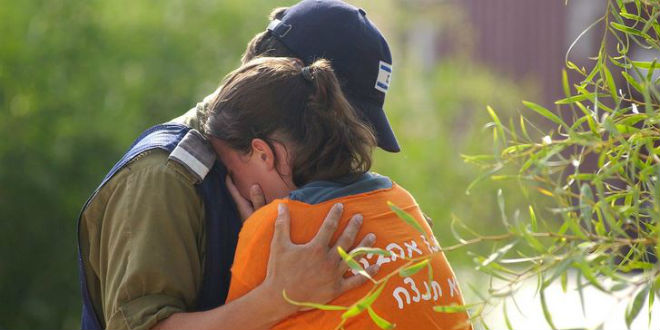
Thousands of houses were razed. Synagogues, schools, factories and greenhouses were left standing. I don't know what happened to the cows on the dairy farm.
After Gush Katif was no more, we learned how well the government had implemented their plan to expel the Jews without embarrassing incident. Before the expulsion I met people living in Gaza who had unshakable faith that no Jew would throw another Jew out of his home. They didn't know about the painstaking effort that went into training soldiers to be psychologically capable of pushing other Jews out of their homes and bustling them out of Gaza. The Government arranged for transportation out of Gaza. They had movers available to help with the packing, although it turned out that securing good in specific storage facilities was less well-planned, and many families never recovered much of their goods. They worked out such details as exhuming the 48 graves in the Gush Katif Cemetery, including those of IDF soldiers from Gush Katif who had fallen in the line of duty and the six residents murdered by terrorists, and moving them to Israel. They budgeted some $500 million to remove military bases and equipment. They arranged for the demolition and removal of rubble at an estimated cost of $25 million. The severely-underestimated cost of disengagement was projected to be $2 billion — which was about half the country's annual health budget or approximately one third of the budget for education for 2005. This in a depressed economy! But Sharon was not deterred. (Emanuel A. Winston, March 4, 2005).
The Arabs celebrated in their traditional way. As the Jews vacated, they entered the towns, vandalizing and torching the remains.
For a while, it looked like the greenhouses would be preserved. Some wealthy Jews — Mort Zuckerman and James D Wolfensohn and a couple of their friends — were concerned that the Gazan Arabs would be unemployed when the Jews left. They generously bought the greenhouses and donated them. As soon as the Jewish community left, many of the greenhouse were demolished by the new owners and the equipment looted.
The Arabs lost no time in doing what they wanted with their new acquisitions. In February 2007, YNet News reported, "The ruins of two large synagogues in Gush Katif, the evacuated Jewish communities of the Gaza Strip, have been transformed into a military base used by Palestinian groups to fire rockets at Israeli cities and train for attacks against the Jewish state, according to a senior terror leader in Gaza." Using the remains of Jewish synagogues rather than some neutral ground was deliberate. It symbolized for the Arabs what their lives were all about: destroying the Jewish homeland so that Islam and Sharia law could thrive.
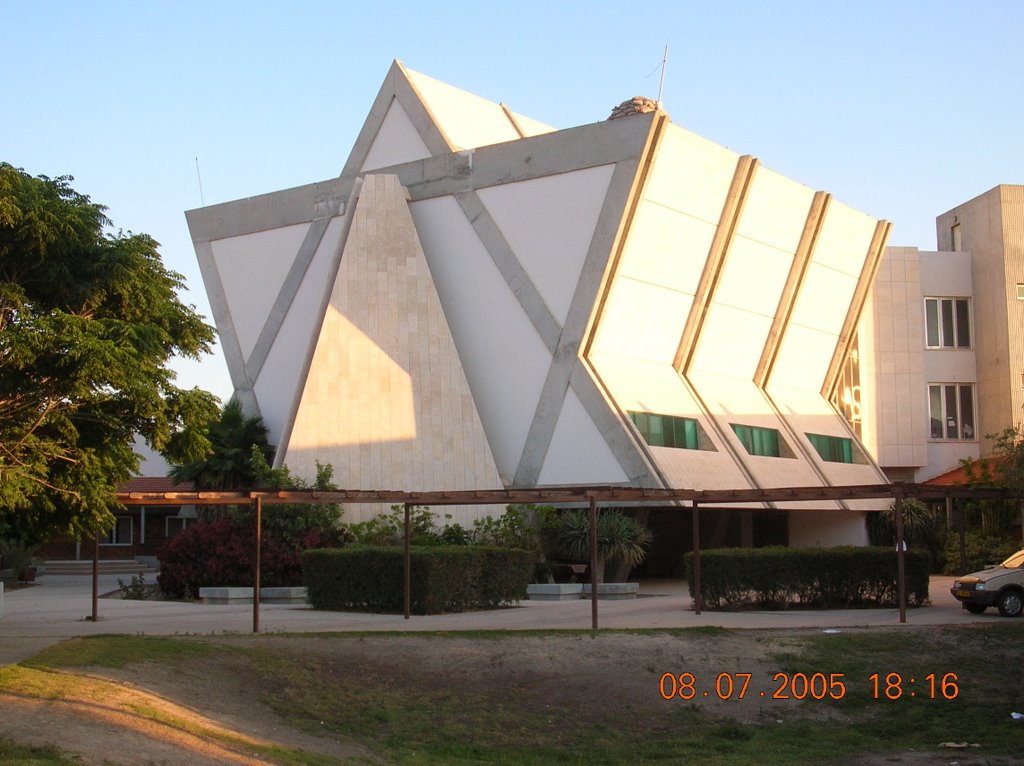
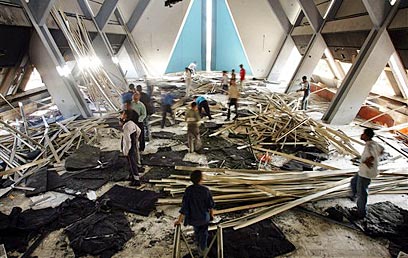
IN CONTRAST TO THE METICULOUS PLANNING FOR a peaceful-appearing expulsion, arranging for the new refugees to be resettled as a community in Israel and given jobs was incredibly sloppy. Men who had brilliantly transformed the landscape of Gush Katif found themselves looking for any sort of work in a depressed economy. (Even today with improved economic conditions, where overall unemployment is around 6%, the rate for the Gush Katif refugees stands at 25%.)
The availability of new housing, schools for the children and access to medical clinics, synagogues and grocery stores were left to chance. These consideration were figuratively a blank space on the planning chart labeled: "To Be Filled In." Not only was permanent housing not ready, even the cardboard trailers — the shoddy but expensive caravillas — that were to house so many of the Gazan Jews were not available for months. The deep need of members of the community to be settled as a community was ignored.
Perhaps if the State had prepared for the influx of Gazan Jews — traumatized, shocked with grief and disbelief, homeless, jobless, demoralized — with the same care and detail with which it psychologically prepared the IDF soldiers assigned to expel their fellow Jews, the process of re-rooting might not have left such as scar on the Gaza Jew's psyche. But the move to the initial temporary quarters was followed by moves to another temporary shelters. Some families are living in tents and some large families were roughing it in tiny apartments — not a sign of careful planning. Often, an uprooted family found the location they were assigned was full and they had to find another place by themselves. Possessions were lost, broken or just tossed by the packers because of lack of room in the container. Well-behaved children became delinquents. Simple tasks such as getting medication for life-threatening medical conditions became giant hurdles as people were shunted between clinic and pharmacy.
To add insult to injury, the families needed to contend with a rigid autocratic bureaucracy. As a Jerusalem Post editorial put it, "they were dealt a very raw deal. The last thing they should encounter now is institutional callousness, bureaucratic run-arounds and official hardheartedness." To determine their compensation, Jewish families discovered — after required documentation was packed or tossed out — that they needed to document answers to questions such as: did your children live with you in Gush Katif? for how long? are they really your children? how long did you live in Gush Katif? Where did your children go to school? Prove it, prove it, prove it. They discovered monthly rent was often much more than their allotment, that they were liable for mortgage payments for houses that no longer existed, that they incurred penalties from insurance companies because they stopped payments on their house premium; that they had to pay rent for the containers storing their goods; and they were charged for some of the costs of moving. They would be booked into a hotel but the bureaucrats hadn't checked the rooms would be available over the entire time they'd be there.
Costs have sky-rocketed, but many of the items suggest corruption, not lavish support of the uprooted. Amounts sufficient to construct proper communities have gone to contractors who built shoddy refugee camps; the State bought land at exorbitant prices, when it owns a great deal of land in the area; people are housed in poorly constructed paper trailers costing $100,000 each and guaranteed for only a few years.
In a report that includes well-documented reports of mean-spirited and incompetent "help" provided by the government and nightmarish anecdotes of what the refugees were up against, we summed up the situation months after the expulsion this way (http://www.think-israel.org/lipkin.gazajews.html):
So what can we say about the casting out of the Gazan Jews from their homes and orchards and greenhouses into the streets? They are patriotic, productive, creative, hard-working and, in the main, religious. The State took a year and a half to relocate animals from the zoo, but the Gazan refugees were brutally kicked out of their towns and villages within days — and given inadequate resources. Much of the promised compensation turned out to be vaporware. Housing described as sturdy homes with roofs that could withstand Arab shelling turned out to be paper trailers guaranteed to self-destruct within 3 years. The only sustained effort has been the harassment and humiliation the refugees suffer at the hands of the government agencies and petty bureaucrats that are supposed to help them, the phone company, the insurance companies and the leftist press — and, of course, there's the reassurances that flow from officialdom that all is well and that almost all the settlers are comfortable and compensated.
Some nine years later, many are still living in temporary quarters. Many are jobless. Families are still living in ramshackle trailers, using the money that was to go to the construction of new homes on everyday expenses. Many are unemployed or underemployed. Many a family has become dysfunctional. There are some shining examples of those who have patched themselves together and by sheer will power gotten on with their lives. But there are too many who once helped drive the economy and are now dependent on state funds.
SO WHY IS THE EXPULSION OF JEWS BY THEIR OWN GOVERNMENT so important — aside from the fact that the Gaza Disengagement will stand for all time as one of the dumbest and disastrous mistakes any Israeli government has ever made. It is because there are politicos that are beginning to mumble again about disengaging from part of Samaria and Judea in the interests of peace. The Arabs have made it quite clear that a Palestinian Arab state will not allow Jews to live in it. This means that were the Government to evacuate Jews from the towns and villages of Samaria and Judea, they will need to come into Israel itself. They won't find housing or help in reconstructing their lives from the Jewish residents of Samaria and Judea, as some of the 2005 refugees did. And the cost of absorbing these new refugees would be astronomical.
Please tell me how a Government that has not been able to complete the resettlement of 10,000 of its citizens in 9 years will cope with the influx of up to a half million new refugees?
End Note: Suggested Videos.
An interview with Anita Tucker, a former farmer in Gush Katif. Would the Gush Katif community return to Gaza? Video included. Click here.
Withdrawal from Gaza, a documentary. Click here.
The Song of Gush Katif. Click here.
Sharon's death and Jewish Gaza. Click here.
Featuring Professor Ben-Artzi. Click here.
The Cohen children: Victims of Gaza Arab terrorists. Click here.
The expulsion from Gush Katif. Click here.
The expulsion from Gush Katif, Part 2. Click here.
And when in Israel visit the Gush Katif Museum in Jerusalem and the Gush Katif Heritage Center in Nitzan.
Bernice Lipkin is managing editor of Think-Israel.